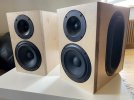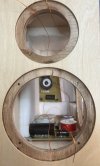…and this is the result. I build up these speakers with a little variation (passive radiators SB15SFCR-00 on the left/right side panel instead of BR vent on the back panel) to avoid the resonance (vent at 1 kHz) and let me easily change the tuning frequency. Without the additional mass, the system (PR and cabinet of ca. 7.5l) has a tuning frequency of 53Hz. Adding ca. 31g will result in a Helmholtz frequency round about 45Hz - this will be the next step in my experiments.Congratulations to Jarek/ @XMechanik for this excellent work. IMO this is a benchmark in price/performance ratio!
And many thanks to Amir for testing this device and taking this contribution to the ASR front page. I think, this is a wonderful opportunity to give DIY-people a constructive feedback about their project with the help of professional tools (who has the opportunity to measure with a Klippel-System?)
By the way, I just ordered a set of these speaker parts...
My instant impression of these speakers was, that they sound so very natural and absolut correct! Even the upper/mid bass is fine, as long as you don’t set the volume too high. These are really amazing speakers at this price level!
I can only repeat the congratulations to @XMechanik for sharing his construction and @amirm for making and publishing the measurements!


